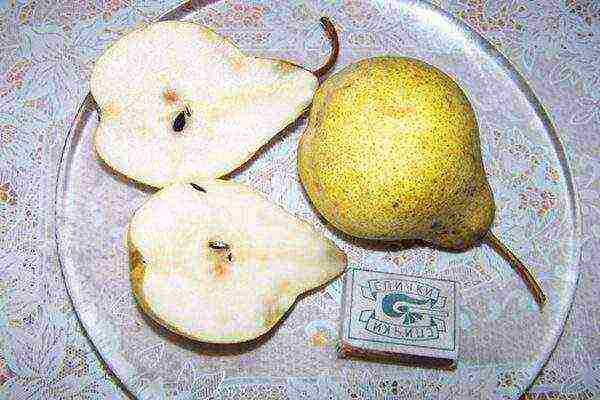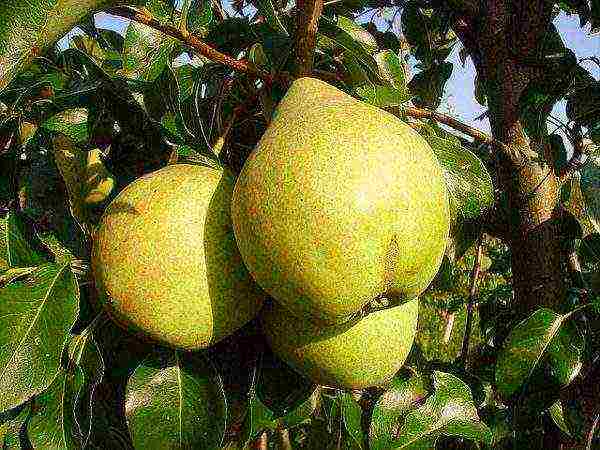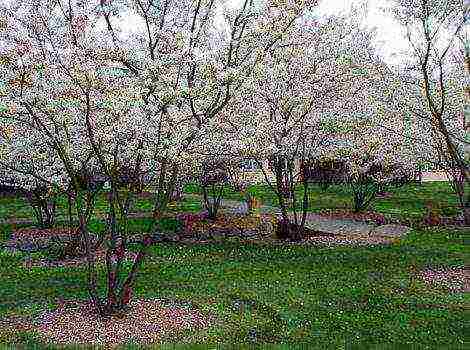Detailed description of the pear variety Prosto Maria
It's just that Maria is considered a new pear variety that ripens at the end of autumn. It's easy to look after her. Thanks to this, the variety is popular among gardeners.
Just Maria is a tree of medium height with a compact wide-pyramidal crown. It is capable of reaching 3 meters. The crown diameter is 2.5 meters.
The history of the appearance and description of the pear Just Maria
It's just that Maria is a pear variety that was bred in Belarus at the Institute of Fruit Growing by crossing a hybrid form 6 / 89-100 and a pear, not very well-known in Russia, Butter Ro.
The authors of the description of this variety and its predominant characteristics were the famous breeders M.G. Myalik, O. A. Yakimovich and G. A. Alekseeva. Initially, the tree was called "Maria", then it was renamed into "Just Maria"... In 2005, this pear variety was sent to the State variety testing.

Pear Just Maria is recognized as a late variety, as it bears fruit in October. And the pear variety Augustovskaya Rosa belongs to the summer. The yield of this variety is good, and severe frosts do not in any way affect the quantity and quality of the fruit. It's just that Maria is considered a winter-hardy variety that can withstand temperatures down to -38 ° C. After freezing, the trees quickly revive and bear a lot of fruit.
The fruits of the pear are quite large. The average weight of ripe fruits is 180 g, the largest is not more than 200 g, but in rare cases it reaches 230 g. Pear-shaped fruits. Their surface is clean, smooth and shiny. Fruit stalks are not particularly long and thick, slightly curved. Fruit color is greenish-yellow with pink blush. Planting pollinators next to a pear can seriously increase its yield.
The pulp of the fruit is creamy in color, their density is medium and oily. The fruit is sweet and juicy in taste, has a slight sourness.
Advantages and disadvantages of the variety
The advantages of the variety include:
- fruit taste that prevails over the rest of the varieties;
- the rapid onset of the fruiting period, that is, the harvest is harvested 3-4 years after planting;
- frost resistance - this variety is able to withstand temperatures of -38 ° C;
- It's just that Maria is characterized by increased resistance to most diseases.
Of the shortcomings, only average yield indicators are noted.
Planting pears
The best place for planting seedlings is the windless southern side of the garden.
The pear is planted in the fall when the leaves fall before the onset of frost. Before planting, seedlings are placed in water for 5-7 hours. When the groove in the ground is ready for planting, they take out the plant. A large hole is dug, its depth is 1–1.5 m. A cone of soil and peat is created in it. The seedling is placed in a hole and the roots are spread over a cone.
Fill the hole with fertile soil, tamping a little... A stake is driven in near the plant, which will act as a support for the future tree. The seedling is tied to the stake with strips of fabric. After planting, the future tree is immediately watered, and the soil around the root is loosened as soon as the soil absorbs water.

Growing conditions
It's just that Maria normally tolerates shady terrain.However, a long stay in such conditions leads to unhealthy development. Because of this, this variety is grown in areas where there is no shade.
For a tree, a sunny place where the shadow partially falls on the tree is suitable.
Maria just needs moisture, especially in the summer. Therefore, it is necessary to create conditions for abundant and constant watering. Trees are watered not only in the first year after planting, but all subsequent time.... Watering is carried out 4 - 5 times per season. It is worth using about three buckets of water for each tree. After watering, it is necessary to loosen the soil so that air can penetrate to the roots.
Care features
The variety Just Maria needs good care. Otherwise, the tree will get sick, it will grow poorly. In the fall, it can be harmed by rodents. In this regard, it is necessary to wrap the stems of the plant with thick paper after planting.
In winter, the root system of the pear may suffer. Therefore, in the autumn, the tree is prepared for frost. For this, an elevation from the earth is created around the pear Just Mary. In addition, for insulation, you can cover the ground with leaves near the plant stem.
Young trees need:
- Have oxygen access to the root system. Therefore, the pear must be loosened and weeded often.
- Frequent fertilization.
- Continuous application of potassium, phosphorus and nitrogen. Nitrogen is mixed with soil and poured into the groove before the pear blossoms.
- For normal fruit ripening at the end of pear flowering, you need to add a 0.4% urea solution.

Harvesting
In terms of harvest time, Just Maria belongs to the autumn varieties. The consumer period of ripeness of this pear lasts from October to November. In the refrigerator compartment, fruits remain fresh until January.
The tree brings its first harvest already in the third year from the moment of its planting. It is possible to collect up to 40 kg of pears from one tree.
Peculiarities
The fruits are greenish-yellow in color and have a shiny skin. One pear fruit weighs approximately 200 grams. Fruits have greenish subcutaneous dots. The fruit contains small dark brown seeds.
Reproduction
Pear Just Maria propagates by cuttings, layering and grafting. Propagation by cuttings is an effective method, which consists of the following steps:
- Take a green stalk from a ripe pear and placed in a temperature of 20-25 ° C. Thus, the cutting will have roots in a short period of time.
- The selected pear stalk must be with leaves... It is necessary to watch how it will take root.
- A film coating is used to maintain the desired temperature. But here such conditions are created for the cutting so that the air does not overheat.
- To save the cutting from overheating, a damp cloth is stretched over it, which does not shade the pear. Otherwise, the plant will weaken and cannot develop properly.
- In the heat, the cuttings are sprayed with water 5-6 times a day, but only when the sun is shining. On cloudy days, this procedure is carried out 2-3 times a day. Sprinkle the pears until the leaves are completely wet.
- Cuttings in the greenhouse are placed so that they slightly exceed ground level.
For this, heteroauxin tablets can be used. These tablets dissolve in water in which the cuttings are placed.

Reproduction by layering Is the simplest method.While the pear will take root, there will be no need to observe the natural conditions. For layering, you need to choose the right shoots from a mature plant.
First, the land is prepared in which the shoots can take root. This requires the landing site to receive water and oxygenate. Also, it should not be exposed to light.
When propagating pears, ordinary shoots are used:
- Almost no harm is done to the parent plant when using this method;
- The branch of the plant is covered with soil, only its top remains;
- Roots are formed in a place where the shoot is covered with earth;
- When the roots appear on the layer in the right amount, it is disconnected from the parent plant.
- For effective root engraftment, it is worth taking shoots with a developed ability to form roots. To do this, branches from the tree are cut one year before laying the roots.
Reproduction by grafting - a complex and lengthy procedure. Its essence is to cut off a branch from one plant and graft to another. The tree on which the grafting is done is called the stock.
For vaccination you need:
- From the middle of the crown of a pear, Just Maria, cut off a few one-year-old cuttings of such length that three or four buds can fit. This action is carried out at the beginning of December, since the first frost hardens the wood.
- The growths are tied in bunches and placed in the basement. There they will spend the winter.
- The stalk is grafted onto a thin branch.
- The rootstock and the scion must be the same in diameter.
- The rootstock cut is made three centimeters.
- For good survival, the scion and stock are cut at an acute angle.
- After fastening the scion and rootstock, they are wrapped in stretch film and fixed with electrical tape.

Diseases and pests
It's just that Maria is resistant to various damage, but the likelihood of infection is still present. In this regard, it is necessary to take measures to prevent septoria, scab and bacterial cancer.
Septoriasis Is a fungal disease. The spores of the fungus are found in fallen leaves. The appearance of this disease can be determined by the appearance of grayish-brown spots on the leaves. For pear treatment, three garden treatments are carried out. Initially, the plant is treated with a nitrophene solution until the buds open. Then the pear is sprayed at the end of flowering with a solution of Bordeaux liquid. And the last time the tree is sprayed 15–20 days after flowering, also with Bordeaux liquid.
Scab is a fungal disease. The spores are stored in the kidneys. Such a disease can be detected when brown spots are detected on the leaves of a pear and on its fruits. The methods of dealing with scab are the same as for septoria.
Bacterial cancer - the disease is also of fungal origin. Signs of this disease: cracked and blackened bark, brown spots are visible on the leaves, the fruit has turned black. In order to prevent a similar pear disease, damage to the bark should be excluded.
Gardeners reviews
Klimenko Irina: It's just that Maria is an incredibly tasty fruit. She can easily compete with southern varieties of pears. At the tasting Prosto Maria is 100% in the first place, because she has such qualities as yield, frost resistance, resistance to diseases and pests.
Lebedev Anton: I didn't really like the taste of the fruit. It seemed sugary to me. Also, of the shortcomings, I can note the shedding of the ovary during the onset of severe cold weather when the pear blossoms.
Volodonskaya Natalia: I have a pear growing on my site Just Maria. I am pleased that it ripens in the fall and is stored for a long time. Taking care of her is not difficult. The fruit itself is sweet and juicy.
Belarusian breeders have developed a truly unique pear variety.It's just that Maria is adapted to cold winters, and this does not affect the quality and quantity of the crop, she is resistant to tree diseases.
And also from it it is possible to regularly receive fruits with high taste characteristics. Plant a Just Maria pear in your garden and enjoy the aromatic fruits!


